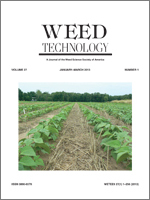Two populations of Palmer amaranth suspected of being resistant to glyphosate have been reported since 2007 in pecan orchards in Doña Ana County, New Mexico. The objectives of the study were to confirm and evaluate the level of resistance, to evaluate the effectiveness of alternative herbicide mechanisms of action, and to compare the cost of effective alternative herbicides for weed management in pecan orchards. Greenhouse experiments indicated that the resistant populations were able to survive glyphosate at 736 g ae ha−1. Compared with a susceptible (S) population, one of the resistant (R) populations had sevenfold resistance to glyphosate. POST application of 12 herbicides, with five different mechanisms of action, all provided at least 88% control of both R and S populations when applied at their recommended field rates. PRE application of trifluralin and metolachlor also provided more than 99% control of R and S populations. The results of field studies indicated that the financial benefit of season-long weed management with glyphosate, in pecan orchards, was comparable with some of the tested alternative herbicides.
Nomenclature: 2,4-D; atrazine; carfentrazone-ethyl; dicamba; flumioxazin; glyphosate; glufosinate; imazethapyr; imazamox; metolachlor; oxyfluorfen; primisulfuron; prosulfuron; pyrithiobac; trifluralin; Palmer amaranth, Amaranthus palmeri S. Wats. AMAPA; pecan, Carya illinoinensis (Wangenh) K. Koch.
Dos poblaciones de Amaranthus palmeri sospechosas de ser resistentes a glyphosate han sido reportadas desde 2007 en plantaciones de pacana en el condado Doña Ana en New Mexico. Los objetivos de este estudio fueron confirmar y evaluar los niveles de resistencia, evaluar la efectividad de herbicidas con mecanismos de acción alternativos, y comparar la eficacia y el costo de herbicidas alternativos efectivos para el manejo de malezas en plantaciones de pacana. Experimentos de invernadero indicaron que las poblaciones resistentes fueron capaces de sobrevivir a glyphosate a 736 g ae ha-1. Comparada con una población susceptible (S), una de las poblaciones resistentes (R) tuvo una resistencia a glyphosate siete veces mayor. Aplicaciones en pos emergencia (POST) de 12 herbicidas, con cinco mecanismos de acción diferentes, proporcionaron un control de al menos 88% para ambas poblaciones R y S cuando se aplicaron a sus respectivas dosis de campo recomendadas. La aplicación en preemergencia (PRE) de trifluralin y metolachlor también brindó mas de 99% de control de poblaciones R y S. Los resultados de estudios de campo indicaron que en plantaciones de pacana, el beneficio monetario de realizar el manejo de malezas a lo largo de todo el ciclo productivo con glyphosate, fue comparable con algunas de los herbicidas alternativos evaluados.





